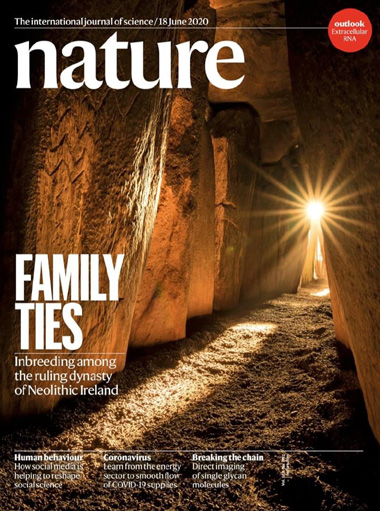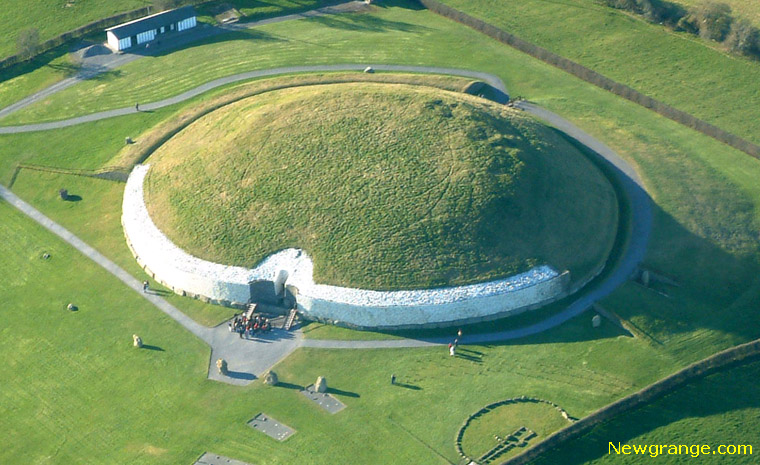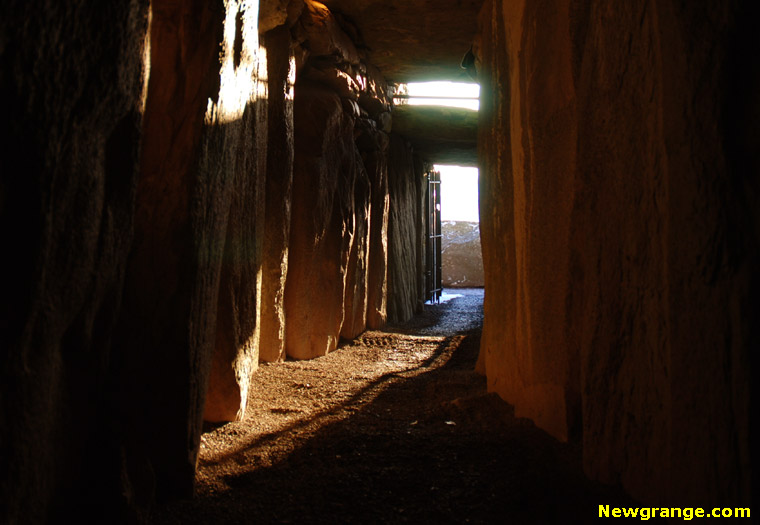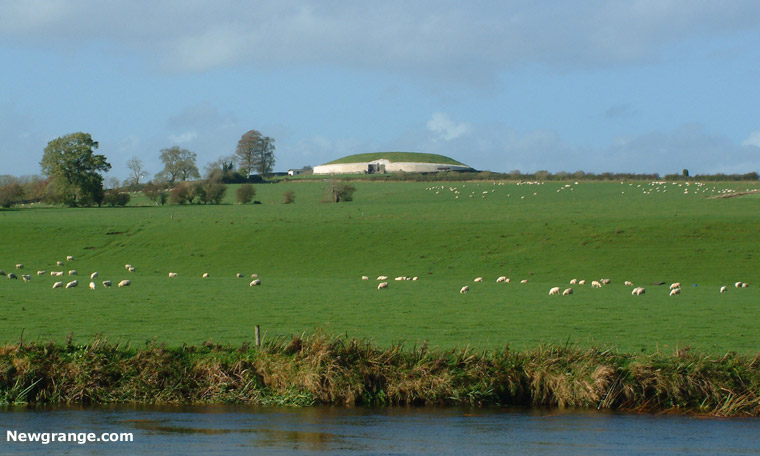Incest uncovered at the elite prehistoric Newgrange monument
 An
article from Nature.com by Alison Sheridan - 17 June 2020
An
article from Nature.com by Alison Sheridan - 17 June 2020
The huge, elaborate, 5,000-year-old tomb at Newgrange, Ireland, is thought to have been built for a powerful elite. DNA of a man buried there reveals a case of incest. Was this a strategy to maintain a dynastic bloodline?
The authors looked at the period, around 4000 BC, when farming appeared as a new, Neolithic way of life, supplanting the older and more mobile Mesolithic lifestyle based on fishing, hunting and foraging for wild foods. Cassidy et al. examined the social structures of these farming communities over the following 1,500 years, focusing on the people buried in passage tombs - a type of monument featuring a chamber, covered by a mound, that is entered along a passage.
The most famous Irish passage tomb is the enormous monument at Newgrange which is part of a World Heritage site of the United Nations Educational, Scientific and Cultural Organization. This huge circular mound is one of three major tombs built in the Brú na Bóinne cemetery complex in the Boyne Valley, north of Dublin, in eastern Ireland.
Newgrange was constructed between around 3200 and 3000 BC. It was built using sophisticated engineering to ensure that, at the end of a long, stone-lined passage, a burial chamber is lit up for a few minutes every year by the rays of the rising Sun, on and around the shortest day of the year. The monument pre-dates, by around 500 years, the huge trilithon stones at Stonehenge, which align to the winter and summer solstices. Marking the winter solstice was crucial for early farmers, who needed to know when the days would start to get longer. It took a massive effort to build Newgrange, and archaeologists think it was constructed as a burial place for a wealthy and powerful elite. People probably journeyed there from far and wide to participate in major solstice-marking ceremonies. Perhaps this elite claimed to have divine power by 'controlling' the Sun's movement.
A study of the DNA of Ireland's Stone Age inhabitants has produced spectacular results, with far-reaching consequences for our understanding of prehistoric population movement and the structure of that ancient society. Writing in Nature, Cassidy et al. report their striking discoveries from this project.
Cassidy and colleagues' analysis of ancient DNA from human remains reveals a rare and unexpected incidence of incest. A man buried in the chamber of Newgrange around 5,000 years ago was the offspring of a first-degree incestuous union: his parents were either siblings or parent and child. This finding led the team to speculate that the elite associated with this magnificent monument practised incest as a way of maintaining a dynastic bloodline. Such a strategy, which breaks a near-universal social taboo against incest, was also practised much later by ruling elites in ancient Egypt, in the Inca empire and in ancient Hawaii.
But this is only one of many revelations from this ground-breaking report. Cassidy et al. carried out whole-genome DNA analysis of 2 Mesolithic and 42 Neolithic individuals, the latter from a variety of burial contexts including caves, passage tombs and other types of monument. By considering their data alongside DNA data previously obtained for 16 Neolithic (approximately 4000-2500 BC) and Early Bronze Age (2200-1500 BC) individuals from Ireland, and for other prehistoric individuals from Britain and continental Europe, Cassidy and colleagues contextualized their results.
The authors' findings address key issues, such as the insularity of Ireland's Mesolithic population, the immigration of Neolithic farming groups and the farmers' relationship with the indigenous Irish Mesolithic fisher-hunter-foragers. The authors also checked whether any genetic links could be detected among and between farmers buried according to particular traditions over the course of the fourth millennium BC. In addition, Cassidy et al. obtained radiocarbon dates and stable-isotope data for 27 individuals, revealing information about diet.
The genetic data obtained from human remains dating to around 4700 BC (from Killuragh Cave, County Limerick, in southwest Ireland) and to around 4100 BC (from Sramore Cave, County Leitrim, in the northwest and Stoneyisland, County Galway, in the west) are the first DNA results for Ireland's hunter-fisher-forager groups. These Mesolithic Irish people were genetically distinct from their Mesolithic neighbours across the Irish Sea in Britain, suggesting a prolonged period of genetic isolation after these people sailed across to Ireland around 8000 BC. In other words, even though they might have ranged widely over Ireland when choosing partners, members of these communities did not sail back to Britain or across to the continent to interact with people there - contrary to what some archaeologists have proposed. Thus, there is no evidence to support some archaeologists' assertion that Mesolithic groups were responsible for introducing the Neolithic farming lifestyle to Ireland.
Instead, Cassidy and colleagues' analysis of remains from Poulnabrone portal tomb (a single-chamber monument with a huge capstone and tall entrance stones) in County Clare, western Ireland, reveals the appearance of new genomic signatures. This indicates the arrival in Ireland of people from elsewhere, from at least as early as 3800 BC, and is consistent with the idea that farming was brought to Ireland by immigrants. These people were genetically affiliated to the Neolithic population in Britain, and their roots lie in continental Europe. One way or another, these immigrants had a major effect on the small and insular indigenous Mesolithic population, whose genetic signature disappeared almost completely over the next few generations. However, DNA evidence from Parknabinnia court tomb (a monument with a segmented chamber and a forecourt) in County Clare shows that indigenous and immigrant intermixing did occur, possibly as late as 3750-3500 BC, and therefore that the indigenous population was clearly not wiped out.
The authors clarify Neolithic population dynamics and familial linkages in Ireland through the analysis of individuals from a variety of burial contexts spanning the fourth millennium BC and extending into the mid-third millennium BC. For those buried in Early Neolithic court and portal tombs, the team found an example of approximately fourth-degree relatives at Parknabinnia, and kinship more distant than that between a man buried at this monument and two men buried at Poulnabrone portal tomb, 7 kilometres away. An earlier study had identified a Neolithic father-daughter pair at Primrose Grange court tomb, County Sligo, in northwest Ireland. Otherwise, the picture is generally one of genetically unrelated groups using the same burial monuments. This implies a fairly sizeable community.
However, Cassidy et al. report that those buried between around 3500 and 2500 BC in passage tombs (and also at a different but related type of monument at Millin Bay, County Down, in the north) display familial relationships that extend over considerable geographical distances and span several generations. People buried in passage tombs also seem to be differentiated from those in other kinds of burial monument by having had a particularly meat-rich diet.
The authors found genetic links between some individuals analysed from the major passage-tomb complexes at Carrowmore and Carrowkeel in County Sligo, and individuals buried 150 kilometres away at Brú na Bóinne (and also at the Millin Bay monument). The authors interpret these links as providing evidence for a non-random selection of partners over large territories, implying a high level of societal complexity. These genetic data support the argument that the trajectory of Irish passage-tomb development over time - generally speaking, going from small and simple to larger and more ostentatious - reflects an increasingly hierarchical society. The evidence of incest found at Newgrange, suggesting dynastic behaviour, is consistent with this overall picture.
Cassidy and colleagues' report has many other fascinating insights, including data on the probable skin, hair and eye colour of the ancient individuals, and the world's earliest definitive evidence (dated to 3629-3371 BC) for a case of Down's syndrome - in an infant boy, buried at Poulnabrone portal tomb. However, there are also contentious issues, not least the use of social-evolutionary terminology. For example, it is questionable to characterize the society of those responsible for building the major Brú na Bóinne passage tombs as possessing attributes found in early state societies and their precursors, with all that that implies in terms of bureaucracy, centralized power structures and so on.
Moreover, in emphasizing the genetic affinities between Irish and British Neolithic farmers and those in Iberia (Spain and Portugal), the authors seem to fall into the trap of assuming that Ireland's farmers had sailed up from Iberia - an argument for which there is no archaeological evidence. Instead, the archaeology points towards the Morbihan area of Brittany in northwest France, and the Nord-Pas de Calais region of northern France, as the ultimate areas of origin for Ireland's immigrant farmers - with those from northern France probably arriving in Ireland via northern Britain. A recently published analysis of DNA samples from Neolithic French farmers lends support to this scenario, revealing that some of these individuals shared elements of this 'Iberian' or 'Mediterranean' genetic signature. But many pieces of the genetic jigsaw are still missing, and more analyses of Neolithic French individuals will be needed to settle the question of the origins of Ireland's first farmers. Nevertheless, Cassidy et al. have produced a fascinating and invaluable study providing much food for thought and debate about prehistoric Irish society.
Alison Sheridan is a research associate and emerita principal curator in the Department of Scottish History and Archaeology, National Museums Scotland. Nature.com
Abstract to the Academic Paper
A dynastic elite in monumental Neolithic societyThe nature and distribution of political power in Europe during the Neolithic era remains poorly understood. During this period, many societies began to invest heavily in building monuments, which suggests an increase in social organization.
The scale and sophistication of megalithic architecture along the Atlantic seaboard, culminating in the great passage tomb complexes, is particularly impressive. Although co-operative ideology has often been emphasised as a driver of megalith construction, the human expenditure required to erect the largest monuments has led some researchers to emphasize hierarchy-of which the most extreme case is a small elite marshalling the labour of the masses.
Here we present evidence that a social stratum of this type was established during the Neolithic period in Ireland. We sampled 44 whole genomes, among which we identify the adult son of a first-degree incestuous union from remains that were discovered within the most elaborate recess of the Newgrange passage tomb.
Socially sanctioned matings of this nature are very rare, and are documented almost exclusively among politico-religious elites-specifically within polygynous and patrilineal royal families that are headed by god-kings. We identify relatives of this individual within two other major complexes of passage tombs 150 km to the west of Newgrange, as well as dietary differences and fine-scale haplotypic structure (which is unprecedented in resolution for a prehistoric population) between passage tomb samples and the larger dataset, which together imply hierarchy. This elite emerged against a backdrop of rapid maritime colonization that displaced a unique Mesolithic isolate population, although we also detected rare Irish hunter-gatherer introgression within the Neolithic population. Nature Academic Paper
A critical analysis of the Newgrange petrous fragment
A Research Paper published in June 2025 takes a closer look at the skull fragment found inside Newgrange, which some researchers had linked to an ancient 'King' or dynastic elite.Boyne Valley Private Day Tour
 Immerse yourself in the rich heritage and culture of the Boyne Valley with our full-day private tours.
Visit Newgrange World Heritage site, explore the Hill of Slane, where Saint Patrick famously lit the Paschal fire.
Discover the Hill of Tara, the ancient seat of power for the High Kings of Ireland.
Book Now
Immerse yourself in the rich heritage and culture of the Boyne Valley with our full-day private tours.
Visit Newgrange World Heritage site, explore the Hill of Slane, where Saint Patrick famously lit the Paschal fire.
Discover the Hill of Tara, the ancient seat of power for the High Kings of Ireland.
Book Now

Home
| Visitor Centre
| Tours
| Winter Solstice
| Solstice Lottery
| Images
| Local Area
| News
| Knowth
| Dowth
| Articles
| Art
| Books
| Directions
| Accommodation
| Contact



